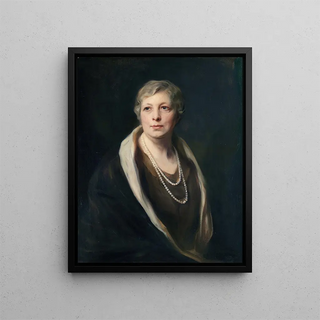Art print | Olive Thring - Philip Alexius de László


View from behind

Frame (optional)
Olive Thring - Philip Alexius de László Art print – Engaging introduction
The "Olive Thring - Philip Alexius de László" artwork is part of a rich artistic tradition that celebrates timeless beauty and human essence. This portrait, both intimate and striking, immerses us in the artist's universe, revealing a psychological depth that transcends mere facial features. By contemplating this piece, the viewer is invited to explore not only the depiction of Olive Thring but also the history and emotions hidden behind each brushstroke. The delicate light and subtle color nuances create an atmosphere that seems to suspend time, allowing everyone to immerse themselves in this encounter between art and life.
Style and uniqueness of the work
Philip Alexius de László's style is distinguished by its ability to capture the personality of its subjects with remarkable precision. In "Olive Thring," the artist uses a palette of soft colors, blending warm and cool tones to create a visual harmony that draws the eye. The meticulous details, such as reflections in the eyes and the texture of the clothing, demonstrate exceptional craftsmanship and attention to every element. This portrait does not merely depict Olive Thring; it also evokes an atmosphere of serenity and dignity. The posture and expression of the subject are carefully chosen to convey a story, an emotion, a frozen moment in time. This artistic approach, blending realism and sensitivity, makes this work a true masterpiece that continues to fascinate art enthusiasts.
The artist and his influence
Philip Alexius de László, born in 1869 in Budapest, is recognized as one of the most influential portraitists of his time. His artistic journey took him across Europe, where he had the opportunity to mingle with iconic figures from the art world and high society. His technique, combining tradition and innovation, marked a turning point in portrait representation at the beginning of the 20th century. De László managed to incorporate elements of the Impressionist movement while remaining faithful to the principles of classical portraiture. His influence endures today, inspiring many contemporary artists who seek to

Matte finish

View from behind

Frame (optional)
Olive Thring - Philip Alexius de László Art print – Engaging introduction
The "Olive Thring - Philip Alexius de László" artwork is part of a rich artistic tradition that celebrates timeless beauty and human essence. This portrait, both intimate and striking, immerses us in the artist's universe, revealing a psychological depth that transcends mere facial features. By contemplating this piece, the viewer is invited to explore not only the depiction of Olive Thring but also the history and emotions hidden behind each brushstroke. The delicate light and subtle color nuances create an atmosphere that seems to suspend time, allowing everyone to immerse themselves in this encounter between art and life.
Style and uniqueness of the work
Philip Alexius de László's style is distinguished by its ability to capture the personality of its subjects with remarkable precision. In "Olive Thring," the artist uses a palette of soft colors, blending warm and cool tones to create a visual harmony that draws the eye. The meticulous details, such as reflections in the eyes and the texture of the clothing, demonstrate exceptional craftsmanship and attention to every element. This portrait does not merely depict Olive Thring; it also evokes an atmosphere of serenity and dignity. The posture and expression of the subject are carefully chosen to convey a story, an emotion, a frozen moment in time. This artistic approach, blending realism and sensitivity, makes this work a true masterpiece that continues to fascinate art enthusiasts.
The artist and his influence
Philip Alexius de László, born in 1869 in Budapest, is recognized as one of the most influential portraitists of his time. His artistic journey took him across Europe, where he had the opportunity to mingle with iconic figures from the art world and high society. His technique, combining tradition and innovation, marked a turning point in portrait representation at the beginning of the 20th century. De László managed to incorporate elements of the Impressionist movement while remaining faithful to the principles of classical portraiture. His influence endures today, inspiring many contemporary artists who seek to






